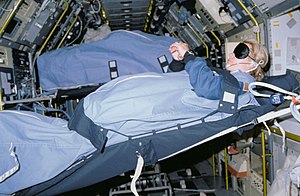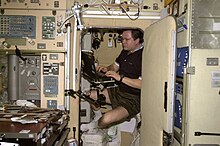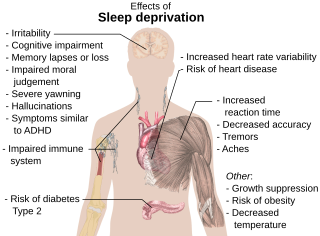
Sleep debt or sleep deficit is the cumulative effect of not getting enough sleep. A large sleep debt may lead to mental or physical fatigue, and can adversely affect one's mood, energy, and ability to think clearly.
Polyphasic sleep is the practice of sleeping during multiple periods over the course of 24 hours, in contrast to monophasic sleep, which is one period of sleep within 24 hours. Biphasicsleep refers to two periods, while polyphasic usually means more than two. Segmented sleep and divided sleep may refer to polyphasic or biphasic sleep, but may also refer to interrupted sleep, where the sleep has one or several shorter periods of wakefulness, as was the norm for night sleep in pre-industrial societies.

Skylab 4 was the third crewed Skylab mission and placed the third and final crew aboard the first American space station.
Shift work is an employment practice designed to keep a service or production line operational at all times. The practice typically sees the day divided into shifts, set periods of time during which different groups of workers perform their duties. The term "shift work" includes both long-term night shifts and work schedules in which employees change or rotate shifts.

The effects of spaceflight on the human body are complex and largely harmful over both short and long term. Significant adverse effects of long-term weightlessness include muscle atrophy and deterioration of the skeleton. Other significant effects include a slowing of cardiovascular system functions, decreased production of red blood cells, balance disorders, eyesight disorders and changes in the immune system. Additional symptoms include fluid redistribution, loss of body mass, nasal congestion, sleep disturbance, and excess flatulence. Overall, NASA refers to the various deleterious effects of spaceflight on the human body by the acronym RIDGE.
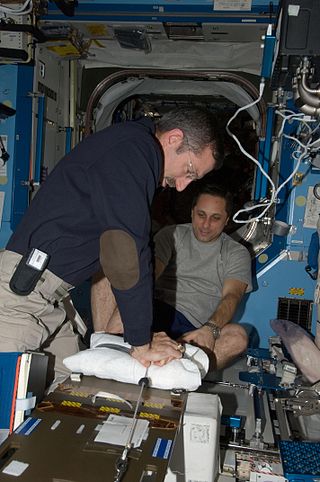
Space medicine is an area in aerospace medicine that focuses on the medical care of astronauts and spaceflight participants. The spaceflight environment poses many unique stressors to the human body, including G forces, microgravity, unusual atmospheres such as low pressure or high carbon dioxide, and space radiation. Space medicine applies space physiology, preventive medicine, primary care, emergency medicine, acute care medicine, austere medicine, public health, and toxicology to prevent and treat medical problems in space. This expertise is additionally used to inform vehicle systems design to minimize the risk to human health and performance while meeting mission objectives.
Shift work sleep disorder (SWSD) is a circadian rhythm sleep disorder characterized by insomnia, excessive sleepiness, or both affecting people whose work hours overlap with the typical sleep period. Insomnia can be the difficulty to fall asleep or to wake up before the individual has slept enough. About 20% of the working population participates in shift work. SWSD commonly goes undiagnosed, so it's estimated that 10–40% of shift workers have SWSD. The excessive sleepiness appears when the individual has to be productive, awake and alert. Both symptoms are predominant in SWSD. There are numerous shift work schedules, and they may be permanent, intermittent, or rotating; consequently, the manifestations of SWSD are quite variable. Most people with different schedules than the ordinary one might have these symptoms but the difference is that SWSD is continual, long-term, and starts to interfere with the individual's life.

Sleep deprivation, also known as sleep insufficiency or sleeplessness, is the condition of not having adequate duration and/or quality of sleep to support decent alertness, performance, and health. It can be either chronic or acute and may vary widely in severity. All known animals sleep or exhibit some form of sleep behavior, and the importance of sleep is self-evident for humans, as nearly a third of a person's life is spent sleeping.
Fatigue is a major human factors issue in aviation safety. The Fatigue Avoidance Scheduling Tool (FAST) was developed by the United States Air Force in 2000–2001 to address the problem of aircrew fatigue in aircrew flight scheduling. FAST is a Windows program that allows scientists, planners and schedulers to quantify the effects of various work-rest schedules on human performance. It allows work and sleep data entry in graphic, symbolic (grid) and text formats. The graphic input-output display shows cognitive performance effectiveness as a function of time. An upper green area on the graph ends at the time for normal sleep, 90% effectiveness. The goal of the planner or scheduler is to keep performance effectiveness at or above 90% by manipulating the timing and lengths of work and rest periods. A work schedule is entered as red bands on the time line. Sleep periods are entered as blue bands across the time line, below the red bands.
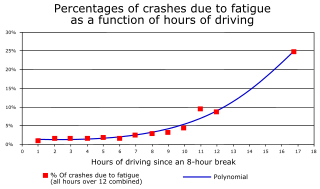
Fatigue is a major safety concern in many fields, but especially in transportation, because fatigue can result in disastrous accidents. Fatigue is considered an internal precondition for unsafe acts because it negatively affects the human operator's internal state. Research has generally focused on pilots, truck drivers, and shift workers.
The effects of sleep deprivation on cognitive performance encompass a broad range of impairments in various cognitive functions resulting from inadequate or insufficient sleep, impacting areas such as attention, memory, decision-making, and reaction time.
In chronobiology, a circasemidian rhythm is a physiological arousal cycle that peaks twice in a 24-hour day. It may also be called the semicircadian rhythm. Numerous studies have demonstrated that human circadian rhythms in many measures of performance and physiological activity have a 2-peak daily (circasemidian) pattern. The word, circasemidian, is based upon the Latin words circa ("about"), semi ("half") and dia ("day"). Thus, this is a rhythm that has two cycles per day, and some investigators have referred to it as the semicircadian rhythm. It usually serves to (1) deepen the pre-dawn nadir in body temperature and cognitive performance, (2) create a flat spot during the early afternoon in the daytime increase in body temperature and cognitive performance, and (3) heighten the early-evening peak in body temperature and cognitive performance. Broughton was the first to bring this characteristic of human performance to the attention of researchers.
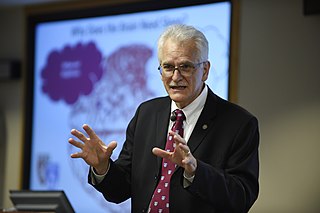
Charles Andrew Czeisler is a Hungarian-American physician and sleep and circadian researcher. He is a leading researcher and author in the fields of the effects of light on human physiology, circadian rhythms and sleep medicine.
It is inevitable that medical conditions of varying complexity, severity and emergency will occur during spaceflight missions with human participants. Different levels of care are required depending on the problem, available resources and time required to return to Earth.
Studies, which include laboratory investigations and field evaluations of population groups that are analogous to astronauts, provide compelling evidence that working long shifts for extended periods of time contributes to sleep deprivation and can cause performance decrements, health problems, and other detrimental consequences, including accidents, that can affect both the worker and others.

Psychological and sociological effects of space flight are important to understanding how to successfully achieve the goals of long-duration expeditionary missions. Although robotic spacecraft have landed on Mars, plans have also been discussed for a human expedition, perhaps in the 2030s, or as early as 2024 for a return mission.

The International Civil Aviation Organization (ICAO) defines fatigue as "A physiological state of reduced mental or physical performance capability resulting from sleep loss or extended wakefulness, circadian phase, or workload." The phenomenon places great risk on the crew and passengers of an airplane because it significantly increases the chance of pilot error. Fatigue is particularly prevalent among pilots because of "unpredictable work hours, long duty periods, circadian disruption, and insufficient sleep". These factors can occur together to produce a combination of sleep deprivation, circadian rhythm effects, and 'time-on task' fatigue. Regulators attempt to mitigate fatigue by limiting the number of hours pilots are allowed to fly over varying periods of time.

Philippa Helen Gander is a New Zealand sleep researcher. In 2021, she was conferred with the title of emeritus professor by Massey University, where she had been inaugural director of the Sleep/Wake Research Centre until stepping down from that role in 2019.

Charmane Eastman is an American academic research scientist whose career has focused on studying circadian rhythms and their relationships to sleep, jet lag, and shift work. She has also studied winter depression, more properly known as seasonal affective disorder (SAD). Of special focus are the effects of bright light and melatonin on circadian rhythms.
Elizabeth Klerman is a professor of neurology at Harvard Medical School. Her research focuses on applying circadian and sleep research principles to human physiology and pathophysiology. She also uses mathematical analysis and modeling to study human circadian, sleep, and objective neurobehavioral performance and subjective (self-reported) mood and alertness rhythms.

